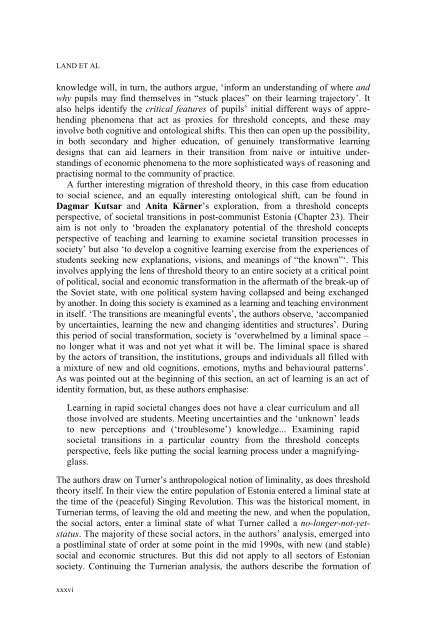1177-threshold-concepts-and-transformational-learning
1177-threshold-concepts-and-transformational-learning
1177-threshold-concepts-and-transformational-learning
- No tags were found...
You also want an ePaper? Increase the reach of your titles
YUMPU automatically turns print PDFs into web optimized ePapers that Google loves.
LAND ET ALknowledge will, in turn, the authors argue, ‘inform an underst<strong>and</strong>ing of where <strong>and</strong>why pupils may find themselves in “stuck places” on their <strong>learning</strong> trajectory’. Italso helps identify the critical features of pupils’ initial different ways of apprehendingphenomena that act as proxies for <strong>threshold</strong> <strong>concepts</strong>, <strong>and</strong> these mayinvolve both cognitive <strong>and</strong> ontological shifts. This then can open up the possibility,in both secondary <strong>and</strong> higher education, of genuinely transformative <strong>learning</strong>designs that can aid learners in their transition from naive or intuitive underst<strong>and</strong>ingsof economic phenomena to the more sophisticated ways of reasoning <strong>and</strong>practising normal to the community of practice.A further interesting migration of <strong>threshold</strong> theory, in this case from educationto social science, <strong>and</strong> an equally interesting ontological shift, can be found inDagmar Kutsar <strong>and</strong> Anita Kärner’s exploration, from a <strong>threshold</strong> <strong>concepts</strong>perspective, of societal transitions in post-communist Estonia (Chapter 23). Theiraim is not only to ‘broaden the explanatory potential of the <strong>threshold</strong> <strong>concepts</strong>perspective of teaching <strong>and</strong> <strong>learning</strong> to examine societal transition processes insociety’ but also ‘to develop a cognitive <strong>learning</strong> exercise from the experiences ofstudents seeking new explanations, visions, <strong>and</strong> meanings of “the known”‘. Thisinvolves applying the lens of <strong>threshold</strong> theory to an entire society at a critical pointof political, social <strong>and</strong> economic transformation in the aftermath of the break-up ofthe Soviet state, with one political system having collapsed <strong>and</strong> being exchangedby another. In doing this society is examined as a <strong>learning</strong> <strong>and</strong> teaching environmentin itself. ‘The transitions are meaningful events’, the authors observe, ‘accompaniedby uncertainties, <strong>learning</strong> the new <strong>and</strong> changing identities <strong>and</strong> structures’. Duringthis period of social transformation, society is ‘overwhelmed by a liminal space –no longer what it was <strong>and</strong> not yet what it will be. The liminal space is sharedby the actors of transition, the institutions, groups <strong>and</strong> individuals all filled witha mixture of new <strong>and</strong> old cognitions, emotions, myths <strong>and</strong> behavioural patterns’.As was pointed out at the beginning of this section, an act of <strong>learning</strong> is an act ofidentity formation, but, as these authors emphasise:Learning in rapid societal changes does not have a clear curriculum <strong>and</strong> allthose involved are students. Meeting uncertainties <strong>and</strong> the ‘unknown’ leadsto new perceptions <strong>and</strong> (‘troublesome’) knowledge... Examining rapidsocietal transitions in a particular country from the <strong>threshold</strong> <strong>concepts</strong>perspective, feels like putting the social <strong>learning</strong> process under a magnifyingglass.The authors draw on Turner’s anthropological notion of liminality, as does <strong>threshold</strong>theory itself. In their view the entire population of Estonia entered a liminal state atthe time of the (peaceful) Singing Revolution. This was the historical moment, inTurnerian terms, of leaving the old <strong>and</strong> meeting the new, <strong>and</strong> when the population,the social actors, enter a liminal state of what Turner called a no-longer-not-yetstatus.The majority of these social actors, in the authors’ analysis, emerged intoa postliminal state of order at some point in the mid 1990s, with new (<strong>and</strong> stable)social <strong>and</strong> economic structures. But this did not apply to all sectors of Estoniansociety. Continuing the Turnerian analysis, the authors describe the formation ofxxxvi




